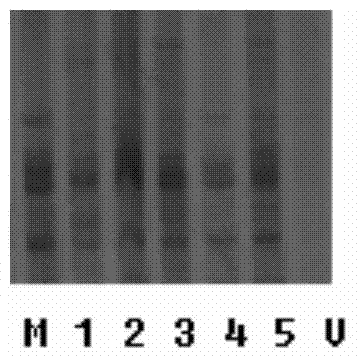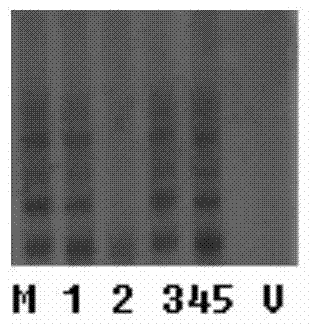Artemisia annua absorbing formaldehyde and its cultivation method
A technology for absorbing formaldehyde and Artemisia annua, applied in the field of genetic engineering to cultivate plants, can solve the problem of no household plants, etc., and achieve the effect of improving the ability to absorb formaldehyde
- Summary
- Abstract
- Description
- Claims
- Application Information
AI Technical Summary
Problems solved by technology
Method used
Image
Examples
Embodiment 1
[0043] 1.1 Shmt and Fdm gene PCR amplification and prokaryotic expression vector construction and enzyme protein expression cloning Shmt degenerate primers:
[0044] Upstream primer Primer1: 5'-ATGCGAATTTTACCGGGTTTTT-3', as shown in SEQ ID NO:3.
[0045] Downstream primer Primer2: 5'-TCGGCTGACATAATAAAACCAACGG-3', as shown in SEQ ID NO:4.
[0046] Clone Shmt PCR primers were designed according to its conserved amino acid sequence:
[0047] Upstream primer Primer3: 5′-AG CATATG CTGGCTAGCTGTTAGCGTTTT-3' (the underlined part is the NdeI restriction site), as shown in SEQ ID NO:5.
[0048] Downstream primer Primer6: 5′-CG CTCGAGG GGCTATAAGTAAACTGAAACGG-3′, (the underlined part is the XhoI restriction site), as shown in SEQ ID NO:6.
[0049] The genomic DNA of Pseudomonas putida was extracted according to the Molecular Cloning Guide, and the PCR reaction conditions were as follows: pre-denaturation at 97°C for 5 minutes, denaturation at 92°C for 1 minute, annealing at 56°C for...
Embodiment 2
[0067] Example 2 Introducing the Shmt and Fdm genes contained in the recombinant plasmid pCB-Fdm-Shmt into the Artemisia annua genome
[0068] 1) The pCB-Fdm-Shmt plasmid prepared above was transformed into Agrobacterium competent cell LBA4404 by electric shock method: pCB-Fdm-Shmt was introduced into Agrobacterium competent cell LBA4404 to obtain LBA4404 / pFdm-Shmt. The implementation steps are based on the English photocopy version 5 "Molecular Biology Mustard Experiment Manual" (Science Press. 2002), using the Agrobaterium (Agrobacterium) electroporation program that comes with the electroporation instrument of Biorad Company. The Agrobacterium into which the plant expression vector was introduced was used for the transformation of Artemisia annua.
[0069] 2) Transformation and regeneration of Artemisia annua: first, transform Agrobacterium, prepare Agrobacterium competent and transform, apply the transformed Agrobacterium liquid to a medium containing kanamycin 60Lg / mL, ri...
Embodiment 3
[0071] Example 3 Using real-time quantitative PCR to analyze the expression levels of Shmt and Fdm genes in positive Artemisia annua plants
[0072] Total RNA was extracted from the bioengineered Artemisia annua plants that were positive by PCR, and reverse-transcribed into cDNA.
[0073] Design primers for the internal reference gene β-actin, and calibrate the internal reference.
[0074] Upstream primer: 5'-GCCACCGATCCAGACACTGTACTTCC-3' as shown in SEQ ID NO:11
[0075] Downstream primer: 5'-ATTCAGGTGATGGTGTGAGCCACAC-3' as shown in SEQ ID NO:12
[0076] Target gene Shmt target gene detection primers (detection primers are shown in SEQ ID NO: 5, 6) as before. Amplification conditions: pre-denaturation at 94°C for 4 min; denaturation at 92°C for 30 S, annealing at 60°C (internal reference gene) or 66°C (adjustable target gene) for 30 S, 38 cycles, extension at 72°C for 10 min, and draw the curve. Such as Figure 4 It can be seen that the expression level of the target gene...
PUM
 Login to View More
Login to View More Abstract
Description
Claims
Application Information
 Login to View More
Login to View More - Generate Ideas
- Intellectual Property
- Life Sciences
- Materials
- Tech Scout
- Unparalleled Data Quality
- Higher Quality Content
- 60% Fewer Hallucinations
Browse by: Latest US Patents, China's latest patents, Technical Efficacy Thesaurus, Application Domain, Technology Topic, Popular Technical Reports.
© 2025 PatSnap. All rights reserved.Legal|Privacy policy|Modern Slavery Act Transparency Statement|Sitemap|About US| Contact US: help@patsnap.com



